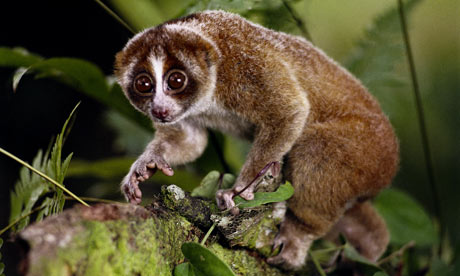
For such an impossibly cute creature, the slow loris has it tough. The giant-eyed nocturnal primates, found across a belt of countries aroundIndonesia, are highly prized for their supposed medicinal and spiritual properties. As a result, the luckless lorises frequently find themselves roasted alive over wood fires while eager people catch the supposedly life-giving liquor that drips out. Bits of their bodies are used in traditional medicine. And legend has it that villagers anxious about traffic safety need only bury a loris beneath a new road to keep it free from accidents.
It gets worse. The slow loris is the world’s only venomous primate. Its venom is stored in an elbow patch: the loris will suck in the venom from the patch, then mix it around in its mouth before delivering a toxic bite. So, when illegal traders catch them and sell them on, they usually remove the hapless creatures’ teeth – with wire cutters. If ever an animal needed to be fast, it is the slow loris. Unfortunately … well you’ve probably guessed.
“They won’t run off like squirrels,” says Alan Knight, chief executive of International Animal Rescue, a UK charity. “They’re more like sloths. Even when we’re transporting them, they will wake up and slowly look around the box. Then they might get up and have a wander around.”
International Animal Rescue is trying to decide what to do with the 31 toothless slow lorises it has collected from concerned tourists and sting operations on illegal market traders in Indonesia. Together with five that still have their teeth, the creatures are housed in a sanctuary on the island of Java. The charity, which works across the world to save animalssuch as the infamous dancing bears of India, usually tries to release rescued animals back to the wild. “But we just don’t know whether these lorises will be able to survive without their teeth,” Knight says.
The group needs money to pay a research student to investigate the secretive animals’ diet and habits, and work out how they might be affected by the missing molars. Some lorises can survive on little more than tree sap, Knight says. Others have been seen at the rescue centre hunting gecko lizards and birds. No teeth required. “They sneak up on the birds, grab them and then strangle them with their hands and feet,” Knight says. “This is totally new stuff. Nobody has looked at this before.”
Source: http://www.guardian.co.uk/






















